Artists' Books
Artists' Books

Errare
ERRARE/WANDERING/WONDERING is a publication by Lucia Palladino that brings together exercises and notes for wild outdoor walking practices in Contemplative Activism. This publication can be used for improvisation and choreographic composition for dancers and actors, but can also be used by everyone as maps for disorientation and deep listening.
Contemplative Activism is an ongoing research in decolonizing, anti-capitalistic practices for the body in relations to the landscape they are immersed in. You find the manifesto of CA inserted in the publication.
Concept and words by Lucia Palladino
Design by Marzia Dalfini
Proofreading by Sarah Cale
Bookbinding by La Rivière Sèche and Lucia Palladino
Co-produced by Nadine for the WAB 2021.

DEARS No. 2 HOPE.FULLY
Robert Steinberger, Delphine Chapuis Schmitz and 1 more
DEARS is a print magazine for transversal writing practices at the crossroads of art, poetry and experimental writing. It brings together authors and writers from different backgrounds and constitutes a dedicated platform for texts escaping the usual genres and disciplinary boundaries.
DEARS promotes the exploration of new forms of language as a way to foster new forms of living together, and emphasizes the growing relevance of trans- versal writing practices in this respect.
DEARS issue no. 2 / HOPE.FULLY / Spring 2021
With texts by Ann Cotten, Barbara Sirieix, Delphine Chapuis Schmitz, Heather Phillipson, Ines Marita Schärer, Kayije Kagame, Legion Seven, Leila Peacock, Louise Guerra Archive, Tarek Lakhrissi, and an epigraph by Rebecca Solnit
Editors are Delphine Chapuis Schmitz, Nicole Bachmann and Robert Steinberger

Untitled
Sasha Phyars-Burgess’ first monograph, Untitled. Spanning three bodies of work, this 200-plus page monograph includes poems by Ser Alida and Aurora Masum-Javed, a conversation between Sasha Phyars-Burgess, Juliana Huxtable and Carolyn Lazard, and essay by Bill Gaskins. Designed by Studio Lin.
As recipient of the second annual Capricious Photo Award, Sasha is a vital, emerging voice in contemporary photography, engaging the charged line between documentary and fine art. Her work ranges from affecting studies on diaspora, family and place to revolving social phenomenons in which energy, beauty and power meet.
The second annual jury panel was helmed by Capricious Founder and Publisher Sophie Mörner and Associate Publisher Anika Sabin alongside Lauren Cornell, Katherine Hubbard, JOFF, Matt Keegan, Guadalupe Rosales, Ka-Man Tse, and Lyndsy Welgos.

wild wild Wild West & Haunting of the Seahorse
wild wild Wild West / Haunting of the Seahorse by Jonathan Lyndon Chase, part of a new book series of experimental narratives. This release of non-linear storytelling illustrates black queer bodies moving through fluid states of love, grief, and desire within the canons of science fiction, fantasy and horror. Like a love letter, Jonathan employs multi-sensory entanglements, a blending of the abstract and physical, to draw out complex histories of blackness, meditations on mental health, and queer futurity.
Jonathan Lyndon Chase is an interdisciplinary artist principally working in modes of painting, video and sculpture depicting queer black love and community amid the backdrop of urban and domestic spaces. This is their second book with Capricious Publishing—a debut book Quiet Storm was released in conjunction with Company Gallery in 2018. Chase was born in 1989 in Philadelphia, PA where they currently live and work.

Randy 2010-2013
RANDY is a 300-plus page full color anthology of RANDY zines spanning 2010-2013. Initiated by artist A.K. Burns and publisher Sophie Mörner, RANDY was a fearless celebration of queer/feminist arts.
Contains over 100 interviews, conversations and projects including work by:
niv Acosta, Jess Arndt, Meriem Bennani, Sadie Benning, Elizabeth Bethea, Ramdasha Bikceem, Cass Bird, Dana Bishop-Root, Pauline Boudry, boychild, Kathe Burkhart, Nao Bustamante, Jibz Cameron, Silvia Casalino, Christelle de Castro, Leidy Churchman, Jon Davies, Hayden Dunham, Celeste Dupuy-Spencer, Nicole Eisenman, Edie Fake, Corrine Fitzpatrick, Daphne Fitzpatrick, Shannon Funchess, Mariah Garnett, Luke Gilford, Julia Gillard, Jules Gimbrone, Reina Gossett, Goodyn Green, Gordon Hall, Harmony Hammond, Onya Hogan-Finlay, Emily Hope, Katherine Hubbard, Amber Ibarreche, Mariana Juliano, Stanya Kahn, Sarah Forbes Keough, Pozsi B Kolor, Adam Krause, Lisa Lenarz, Katerina Llanes, Amos Mac, Lee Maida, India Salvor Menuez, Lessa Millet, MPA, Ulrike Müller, Sheila Pepe, Litia Perta, Cassie Peterson, Isaac Preiss, R.H Quaytman, Jen Rosenblit, Colin Self, Mel Shimkovitz, Amy Sillman, Tuesday Smillie, Jazmin Venus Soto, Matthew Stone, Ginger Brooks Takahashi, Lanka Tattersall, Wu Tsang, Scott Valentine, Leilah Weinraub, Hanna Wilde, Martha Wilson, Io Tillett Wright, Geo Wyeth, Yes! Association/Föreningen Ja!

Deep Scroll
From theory-inspired poetry to technocratic desires concealed behind razorblades; from anarchy to mass-entertainment; from the collapse of binary distinctions of scale to post-human architecture; from the vibratory power of sound and vision to crowds, to the rejection of natural essentialism, materialist universality, and the haunted houses of the Anthropocene, all can be found in Deep Scroll. Edited by the artist Anne de Vries in collaboration with an AI text generator, this book offers an offline domain in which a network of artistic gestures and theoretical contributions are collected for your scrolling needs.
Comprising a range of scrolling pathways that serve as hyperlinks and references to past art projects, sketches, research, and documentation, this book overflows with texts and collages that generate ambiguous algorithms that fleetingly capture the focus of our configurations. All content smoothly flows, driving an accelerated state of correlation to the point of its collapse. Deep Scroll is designed to be reactive; it may induce an epiphany, or to leave the reader at the nadir of a cognitive abyss.
DEEP SCROLL is an artist publication produced in collaboration with AISSystem and Onomatopee. This limited edition contains contributions by Ariella Azoulay, Alain Badiou, Iain Hamilton Grant, Amelia Groom, Nicholas Korody, AI text generators, and many others.

== #2 (edition)
First launched in 2012, and published by mfc michèle didier (micheledidier.com), == is a small-run arts publication, edited by Matt Keegan. ==#2, 2015, is designed by Su Barber and published in an edition of 500 by Capricious Publishing. Barber and Keegan worked together on North Drive Press (northdrivepress.com) between 2005-2010, and this publication shares a variety of traits with NDP.
==#2 is a non-thematic arts publication contained in a box with a 96-page bound volume featuring artist-to-artist interviews, texts, and transcriptions. Six loose multiples are also included.
Contributors include: Sam Anderson, Uri Aran, Fia Backström, Darren Bader, Judith Barry, Stefania Bortolami, Daniel Bozhkov, Milano Chow, Anna Craycroft, Lucky DeBellevue, Cristina Delgado, Haytham El-Wardany, Jake Ewert, Vincent Fecteau, Corrine Fitzpatrick, Harrell Fletcher, Rachel Foullon, Aurélien Froment, Kenny Greenberg, Calla Henkel, Leslie Hewitt, Jaya Howey, Adelita Husni-Bey, Iman Issa, Ruba Katrib, Jill Magid, Jo Nigoghossian, Aaron Peck, Max Pitegoff, David Placek, Olivia Plender, Lisa Robertson, Andrew Russeth, Amy Sillman, Diane Simpson, Greg Parma Smith, Jessica Stockholder, Martine Syms, and Anicka Yi.

Se Te Subió El Santo (Are You In A Trance?)
Se Te Subió El Santo is a collection of self – portraits taken by the artist directly after she awoke every morning while away on a week-long residency in Iowa City, IA at the Center for Afrofuturist Studies in Spring 2016. This daily practice confronts notions of the artist’s interests in rendering a full self implicit of gender, race, sexuality, and spirituality while challenging and collapsing the intersections of each identity as well.
The title of the work is taken from Ana Mendieta, the Iowa Years: A critical study, 1969 through 1977 where Julia Ann Herzberg writes in the dissertation:
Ana and Raquelin Mendieta’s vocabulary contained many Afro-Cuban idiomatic expressions. For example, they would often respond to a friend who was acting in an unruly or hyperactive manner by asking” “Se te subió el santo? (“Are you in a trance?”) In the Afro-Cuban context, the expression “subirse el santo” is used in religious ceremony when the orisha/saint takes possession of the believer.
The monograph also includes an essay by author Akwaeke Emezi.
First edition, 94 page, black and white, leather bound hardcover with white foil embossment
TIONA NEKKIA MCCLODDEN is an interdisciplinary research-based conceptual artist, filmmaker and curator whose work explores, and critiques issues at the intersections of race, gender, sexuality and social commentary. McClodden’s interdisciplinary approach traverses documentary film, experimental video, sculpture, and sound installations. Themes explored in McClodden’s films and works have been re-memory and more recently narrative biomythography.

Non-Human Persons
The first book of Melanie Bonajo’s new series, Matrix Botanica.
Non-Human Persons explores our relationship with Nature photography, animals and the Internet. It is a 140+ page, softcover, full-color, magazine-style artist book designed by Experimental Jetset.
Can we send funny animal pictures to space for aliens to discover the Earth’s ecosystem? Our enormous access to animal pictures on the Internet tramples our awareness that only humans possess self awareness, language, culture, land and customs. But when does a lion stop being a lion? How are typical Nature photography categories designed by the hands of science replaced by the images of amateurs who document the disappearing surroundings of wildlife by ever expanding urbanization? As a result, do we need complete revised scientific categories for these images?
For 10 years, Melanie Bonajo has collected thousands of animal pictures online, this book is her exploration of these questions.

Girls Against God Issue #2
In collaboration with cross-disciplinary artist Bianca Casady of music duo CocoRosie, 2013 brought the release of a new print magazine entitled Girls Against God (GAG). A boldly feminist exploration and multi-generational endeavor, GAG deploys the arts to illuminate the oppressive, obsolete nature of traditional, male-defined religions and other patriarchal institutions—“We must resist and reinvent,” Casady declares.
The second issue of GAG—a pocket book of practical magic—investigates and celebrates spiritual healing, instinctually tying together the earth and women’s bodies. Through essays, fiction, poetry, interviews and spells GAG Issue 2 delves into the roots of occult earth wisdom passed through generations of women against persecution and patriarchy. Texts are accompanied by rich black and white images ranging from pen and ink illustrations to enigmatic photography. The issue gathers around a collaborative photographic exploration between Casady and performance artist Melanie Bonajo entitled “Witchunt,” and also includes interviews with notable artists Carollee Schneemann and Suzanne Lacy
Issue #2—Melanie Bonajo / Eve Bradford / Trinie Dalton / Karolina Daria Flora / Mary Hanlon / Julie Higonnet / J.ZarA / Emely Neu / Kara L. Rooney / Jean Marc Ruellan / Minka Sicklinger / Macho Mel Shimkovitz
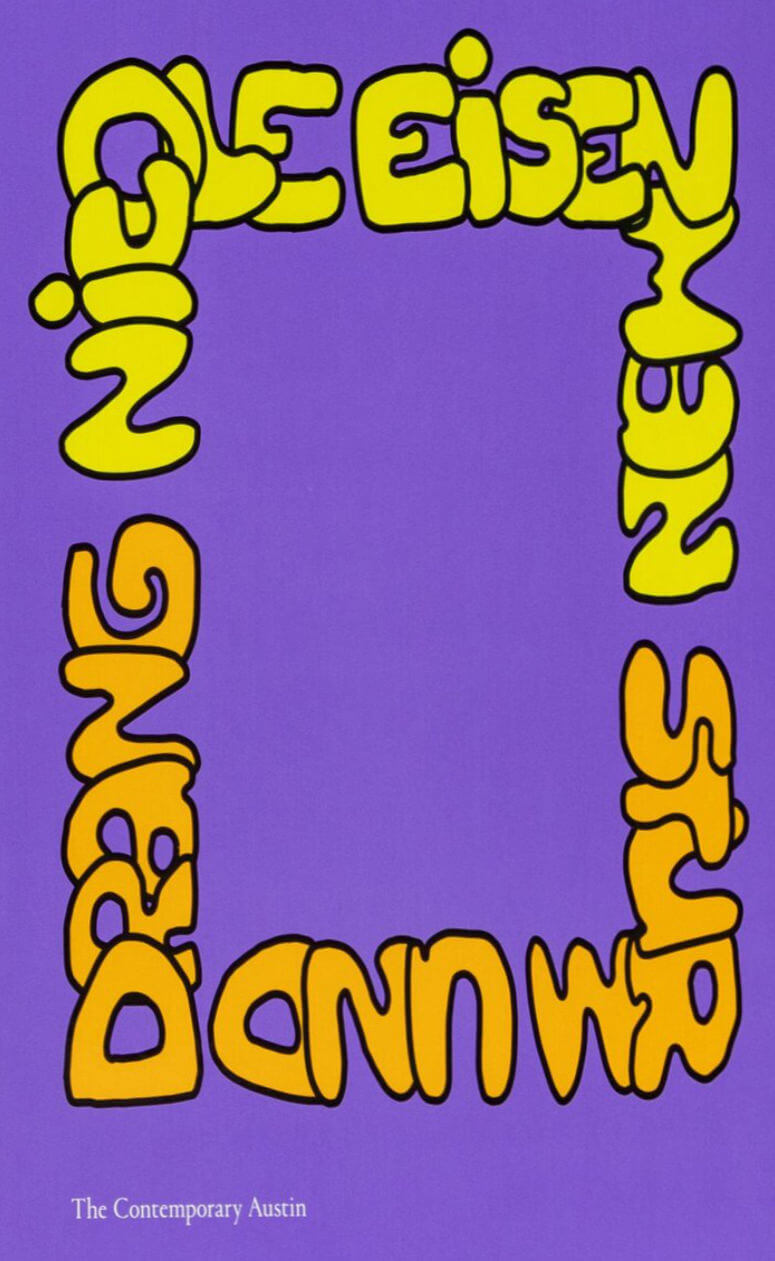
Sturm und Drang
This book accompanies the 2020 Suzanne Deal Booth / FLAG Art Foundation Prize exhibition, Nicole Eisenman: Sturm und Drang. The exhibition ran from February 27 through November 15, 2020, at The Contemporary Austin’s downtown venue, the Jones Center on Congress Avenue, with an outdoor sculpture at the museum’s fourteen-acre sculpture park at Laguna Gloria. A related exhibition of Eisenman’s work with a selection of drawings by Bay Area artist Keith Boadwee, Nicole Eisenman and Keith Boadwee, is on view at The FLAG Art Foundation in New York December 12, 2020, through March 13, 2021.
NICOLE EISENMAN was selected for the prize by an independent advisory committee comprising renowned curators and art historians from across the United States. The artist’s practice blends influences from Western art history and traditional figurative art with elements of punk, feminist activism, queer identity, humor, and emotional rawness to create profoundly unique works. Eisenman emerged in the early 1990s in New York City as a painter, and her creative output for nearly three decades centered on painting. More recently, however, the artist’s three-dimensional objects have overturned expectations of her work and of figurative sculpture. This publication reflects on the sculptural impulses within Eisenman’s work, considering the recent shift in her practice as both a new focus and always-present undercurrent brought to the surface.
Co-published with The Contemporary Austin and The FLAG Art Foundation
Essay by Heather Pesanti
Essay by Stephanie Roach and Jonathan Rider
Essay by Nicole Eisenman
Text by Litia Perta
Essay by Alhena Katsof
Conversation with Nicole Eisenman and Keith Boadwee
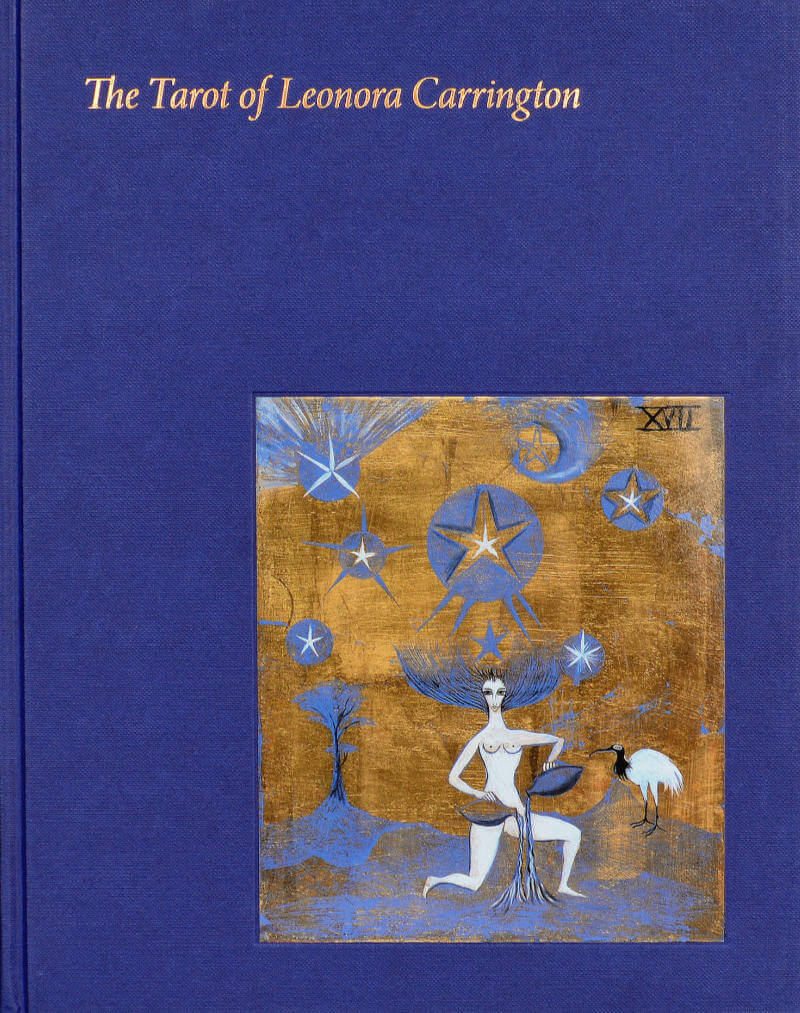
The Tarot of Leonora Carrington
An oracular Surrealism: the debut presentation of Leonora Carrington's recently discovered tarot deck.
The British-born artist Leonora Carrington is one of the more fascinating figures to emerge from the Surrealist movement. As both a writer and painter, she was championed early by André Breton and joined the exiled Surrealists in New York, before settling in Mexico in 1943. The magical themes of Carrington's otherworldly paintings are well known, but the recent discovery of a suite of tarot designs she created for the Major Arcana was a revelation for scholars and fans of Carrington alike.
Drawing inspiration from the Tarot of Marseille and the popular Waite-Smith deck, Carrington brings her own approach and style to this timeless subject, creating a series of iconic images. Executed on thick board, brightly colored and squarish in format, Carrington's Major Arcana shines with gold and silver leaf, exploring tarot themes through what Gabriel Weisz Carrington describes as a "surrealist object." This tantalizing discovery, made by the curator Tere Arcq and scholar Susan Aberth, has placed greater emphasis upon the role of the tarot in Carrington's creative life and has led to fresh research in this area.
The Tarot of Leonora Carrington is the first book dedicated to this important aspect of the artist's work. It includes a full-size facsimile of her newly discovered Major Arcana; an introduction from her son, Gabriel Weisz Carrington; and a richly illustrated essay from Tere Arcq and Susan Aberth that offers new insights—exploring the significance of tarot imagery within Carrington's wider work, her many inspirations and mysterious occult sources.
Leonora Carrington (1917-2011) was born in Lancashire, England. In 1936, she saw Max Ernst's work at the International Surrealist Exhibition in London, and met the artist the following year. They became a couple almost immediately. When the outbreak of World War II separated them, Carrington fled to Spain, then Lisbon, where she married Renato Leduc, a Mexican diplomat, and escaped to Mexico, where she became close with Remedios Varo and other expat Surrealists.
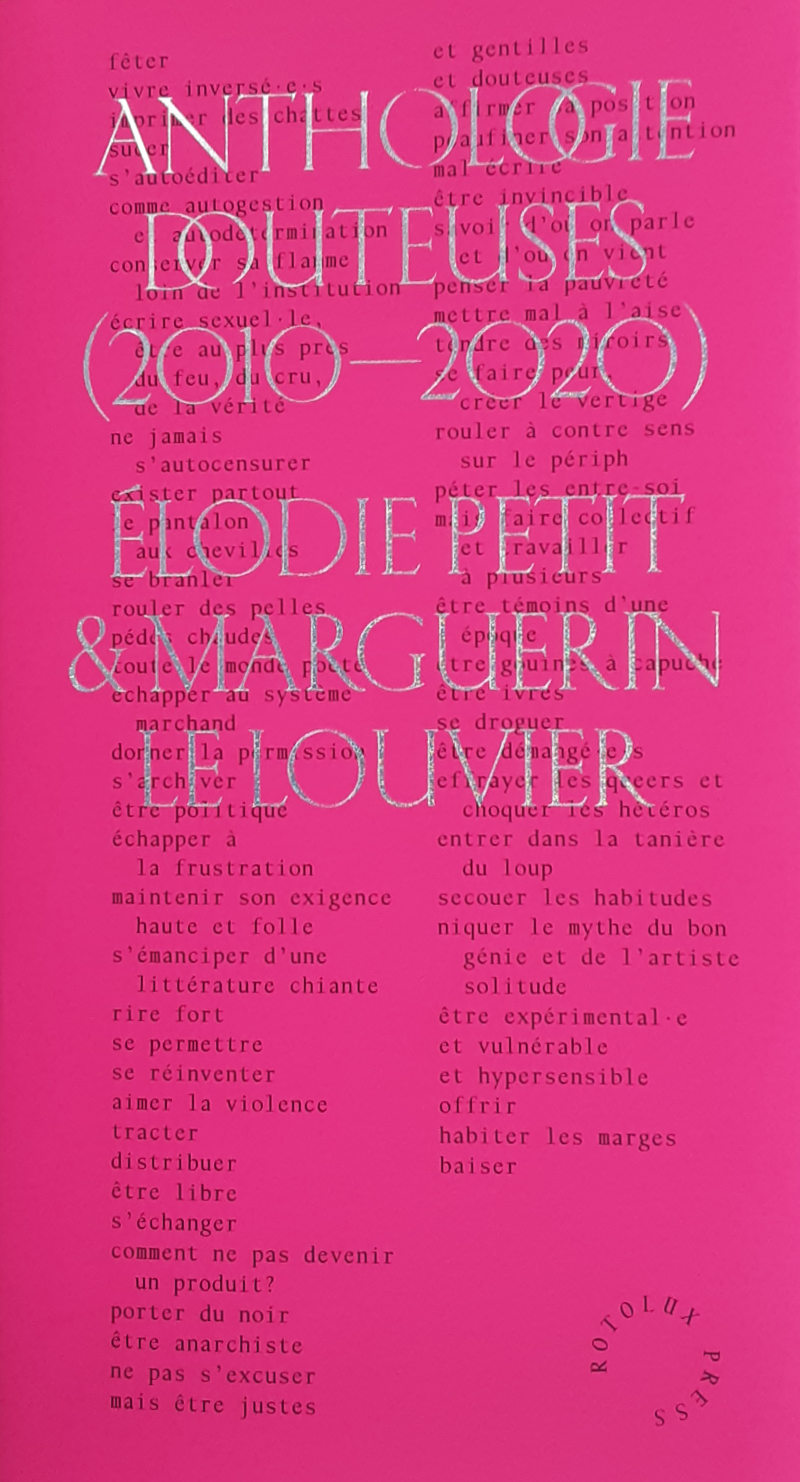
Anthologie Douteuses (2010—2020)
Élodie Petit, Marguerin Le Louvier
Élodie Petit et Marguerin Le Louvier écrivent des poèmes brûlants, sexuels, politiques et les autoéditent depuis leurs chambres sous la bannière commune des Éditions Douteuses. En une décennie, ils produiront des dizaines de textes courts et incisifs, imprimés en noir sur papiers colorés, parfois fluo, formats A5 ou A6 agrafés. À tirages variables, ils seront diffusés lors de soirées lectures-performances dans des bars ou des institutions artistiques, dans des salons de micro-éditions underground ou parfois sous le manteau. L’Anthologie Douteuses (2010—2020) rassemble pour la première fois ces textes en un seul volume, où l’arrangement chronologique donne à voir une certaine évolution de leur pratique littéraire sur dix ans.
« Des incendies savamment allumés au fuel de l’ironie, du fun et du détournement, de la critique sociale et sexuelle, de la pensée radicale et de la poésie merveilleuse. Des contre-feux révolutionnaires joyeusement embrasés par une gouine et un pédé mal repassés du col, qui écrivent, baisent, dessinent, dansent, et s’asseyent en gloussant sur le visage de tous les «culs cousus» et autres suceurs de vieux noyaux. (...) Oui, cette tendresse, leur tendresse, celle d’Élodie et de Marguerin, je crois, nous guérira de tout et leurs merveilleux textes, enfin réunis en un seul et même volume, il faudra les lire quand le courage de vivre, d’aimer et de faire la révolution viendra à nous manquer. Moi, c’est ce que je ferai. » Extrait de la préface d’Anne Pauly.
« Le feu, dans cet ouvrage, est partout invoqué, sussuré, explosé. Il se coule dans les pratiques poétiques queer, matérialistes et révolutionnaires des deux artisan·e·s de ce programme politique. Les éditions douteuses sont un mode d’emploi pour des alliances radicales trans-pédés-gouines-et-au-delà, un appel à une nécessaire profusion-collusion de nos appartenances, de nos situations, et à la production d’intervalles de revendications et de combats partagés. » Extrait de la préface de Thomas Conchou.

Paris la consciencieuse : Paris la guideuse du monde
Frédéric Bruly Bouabré (1923-2014) is an Ivorian artist, poet, “re-searcher”, creator and inventor of the Bété syllabary. In 1989, he was thrust to the front of the international artistic scene during the Magiciens de la terre exhibition (May 18 – August 14, 1989, Centre Georges Pompidou, Grande Halle de La Villette, Paris). Introduced alongside a hundred other artists from all over the world, he would subsequently become world famous for his drawings on maps enhanced with colored pencil.
But in May of that year, Bruly Bouabré still cherished quite a different dream: that of becoming a writer. As he was getting ready to fly to Paris, leaving African soil for the first time, the poet was commissioned by his friends Odile and Georges Courrèges (then director of the French Cultural Center of Abidjan) to write the story of his trip. This is how, a few weeks after his return, Frédéric Bruly Bouabré would submit his “report” of 325 handwritten pages produced in “33 days”, in which he gleefully recounts his journey – at times punctuated by insignificant events – while questioning the place of Man in Western society.
Until now, this tale of “a blind man in Paris,” as he first was to call it, had remained unpublished. The text – of pleasing findings and enchanting language – is that of an observer seeking to understand a changing world, with his own culture as a starting point. Imbued with such freedom and desire for identification and documentation, which characterize the work of this encyclopedic creator, the book is a very unique testimony to a milestone in the history of contemporary art.
Initiated by Odile and Georges Courrèges, who provided publishers with a copy of the manuscript entrusted to them by the artist, the project for this publication was also made possible thanks to André Magnin, who provided the original manuscript.
Foreword by Jean-Hubert Martin

Artists as Iconographers
Aurélien Mole, Garance Chabert
For over a century now, iconographer artists have fuelled their approach by tapping into the diversity of images produced by othersand spread through society by industrial means. From collage to the post-internet school, from archival installations to Appropriationist quotation and image constellations, the present book puts these art practices into perspective, focusing on the last forty years, an extraordinarily dynamic period that recently witnessed the invention and development of a new way of disseminating information and images, the internet. Through theoretical texts, artists’ interviews, and exhibition practices, the book maps the connections artists maintain with images and examines emotion as the driving force in our interactions with them.
Editors: Garance Chabert & Aurélien Mole
Texts: François Aubart, Garance Chabert & Aurélien Mole, Ingrid Luquet-Gad, Jan Verwoert.
Interviews: Pierre-Olivier Arnaud, Barbara Breitenfellner, Céline Duval, Haris Epaminonda, Aurélien Froment, Wade Guyton, Camille Henrot, Thomas Hirschhorn, Pierre Leguillon, Jonathan Monk, Clément Rodzielski, Linder Sterling, John Stezaker, Oriol Vilanova, by Timothée Chaillou.
32 pages leaflet, Turmoil, Batia Suter, 2020, layered reproductions excerpt from a series in progress, various size. Courtesy of Batia Suter.

Fugues
FUGUES is a study of objects. Elements repeat and imitate one another like a polyphonic canon of voices narrating stories of domestic confinement in looped time.
With images by photographer Nicole Maria Winkler & texts by artist Issy Wood, writer Ella Plevin, model Freja Beha Erichsen and curator Elaine Tam.

Real State
Real state is the first publication by artist Asta Meldal Lynge, a visual essay with text by Eleanor Ivory Weber, that takes a critical stance towards the subjects of housing, urban development and image production. Employing video-stills, photographs and found images, Lynge explores the social and political value of the image, in a specifically urban context, emphasising the fictions present in the (re)production of space.
In particular, Real state investigates the ramifications of architectural renderings within the public sphere, documenting building site hoardings, symbolic points at the threshold of construction, where a yet-to-exist everyday and a predicted image of the city meets the real one.
Processing this documentation through layering, editing and retouching, Lynge highlights (and challenges) both the intensifying tendency of ‘image-building’ or the production of buildings as icons and the subsequent transformation of public space into an infinite extension of image surfaces.
As the content is framed and re-framed, trackpad gestures are overlaid, ultimately bringing the stability of any image surface into question. This destabilising approach is mirrored in Weber’s text which combines excerpts from e-mail conversations, with differing registers of fiction, expanding on the disconnection between the idea of housing as a basic human need and its position within market logic and neoliberal ideology.
The book’s title alludes to these systems at play, both the power structures of governed entities and the business of real estate; whilst troubling the promise that there is something real or true to be revealed.

shelf documents: art library as practice
How can art libraries be generative resources and sites of action for all who identify as queer, as women, as Black, as Indigenous, as people of colour? What does it mean to consider the art library as a collective practice that spans multiple scales? In shelf documents artists, writers, curators, teachers, and librarians reflect on their engagements with books, libraries and art-library-as-practice.
Between a reader, an artist’s book, a project documentation and a catalogue, shelf documents might recall a pamphlet, a roadmap, or a recipe book that doesn’t tell you what to do. It is a book that gets mis-shelved.
With drawings by Heide Hinrichs
Edited by Heide Hinrichs, Jo-ey Tang and Elizabeth Haines, and designed by Sara De Bondt.
shelf documents: art library as practice features contributions by Sara De Bondt, Rachel Dedman, Elizabeth Haines, Heide Hinrichs, Laura Larson, Samia Malik, Melanie Noel, Marisa C. Sánchez, David Senior, Jo-ey Tang, Ersi Varveri and Susanne Weiß.
Published by Track Report, Antwerp and b_books, Berlin.
Published in January 2021

EAAPES — reader #5
Clara Pacotte, Charlotte Houette
Cinquième édition de la série des lecteurs.
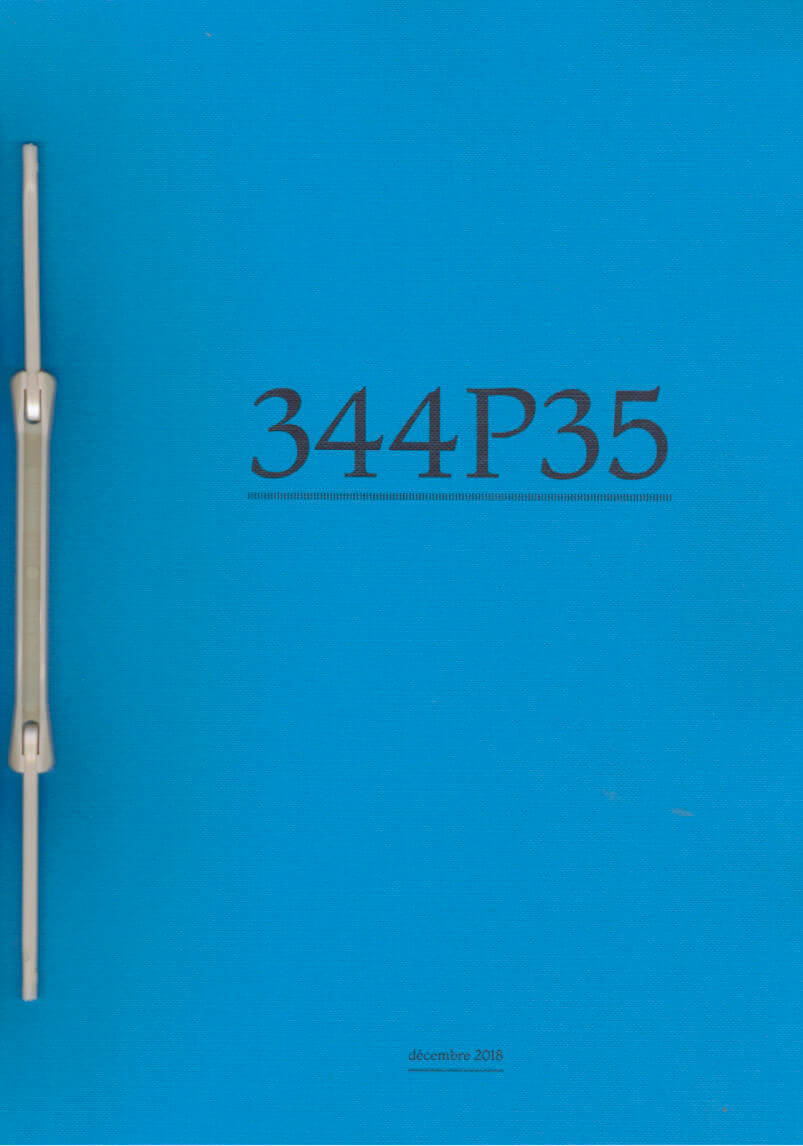
EAAPES – reader #2
Charlotte Houette, Clara Pacotte
Recherches du groupe EAAPES initié par Clara Pacotte et Charlotte Houette autour des questions queer et de féminismes dans la littérature de science-fiction/fiction spéculative.
Contient des traductions de nouvelles de plusieurs autriX tirées du recueil Sisters of the Revolution publié par Ann & Jeff Vandermeer, des interviews, des textes originaux, des articles plus contemporains, des extraits de fictions déjà publiées.
Les textes en langue étrangère sont tous traduits en français.
Avec les contributions de Alexia Foubert, Antoine Trapp, Ariane Sirota, Barbara Sirieix, Camille Pageard, Dora Diamant, Hélène Baril, Laetitia Paviani, Loraine Furter, Louise Truc, Luz De Amor, Mélodie Simonnet, Mirion Malle, Rosanna Puyol, Roxanne Maillet, Théo Robine Langlois.
Pub. dec 2018
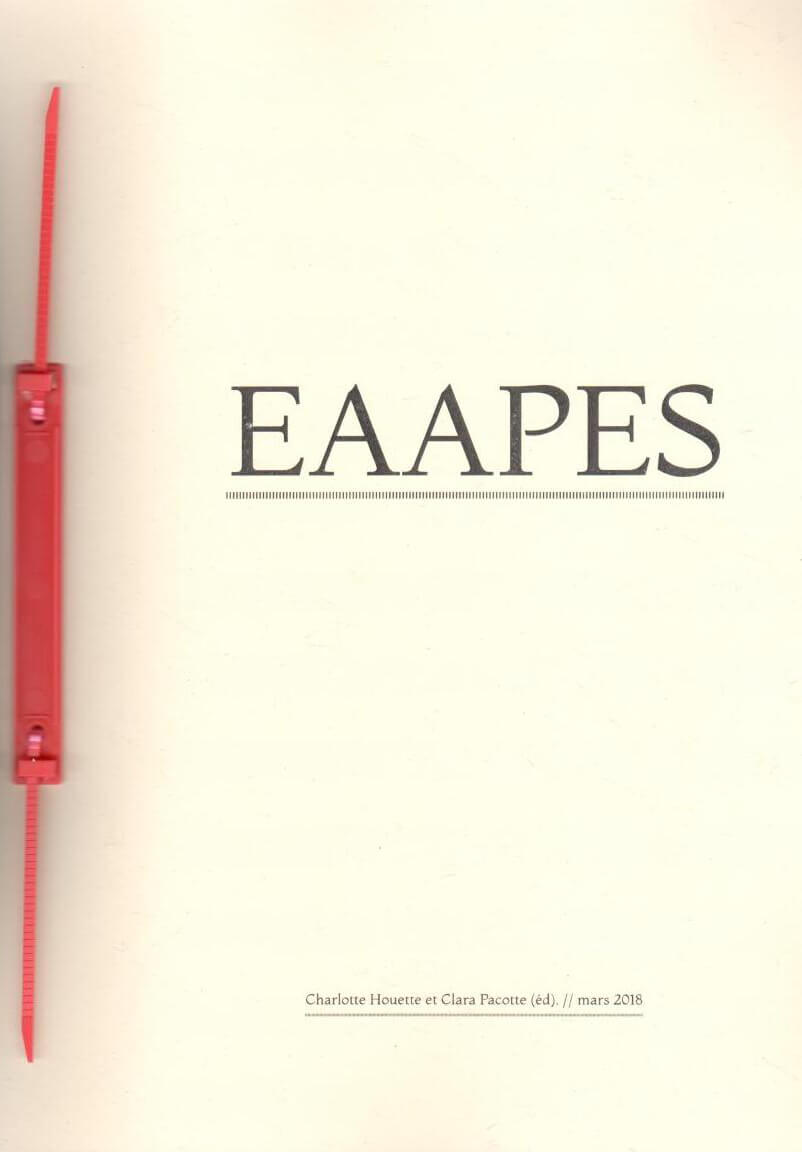
EAAPES — reader #1
Charlotte Houette, Clara Pacotte
Recherches du groupe EAAPES initié par Clara Pacotte et Charlotte Houette autour des questions queer et de féminismes dans la littérature de science-fiction/fiction spéculative.
Contient des traductions des essais de Joanna Russ du recueil To Write Like A Woman, des interviews à la Wiscon, des textes originaux, des articles plus contemporains, des extraits de fictions déjà publiées.
Les textes en langue étrangère sont tous traduits en français.
Avec les contributions de Adèle Iris, Adèle Rolland, Maïwenn Le Mouée, Esmé Planchon, Nana Benamer, Josèfa Ntjam, FLG.
Pub. 2018

Collective Wandering
Collective Wandering, Hanging Out With Our Everyday Ecology, is not a manual in the traditional sense, with linear instructions or guidelines - rather, it is a hopefully engaging and activating collection of insights, moments and encounters, experienced during my continuing artistic research On Tour. What started out as a solo adventure consciously evolved into a collaborative and collective journey.
The intention of this manual is to inspire and support kindred individuals who are in search of an alternative rhythm of learning-working-living. Sharing multiform co-production processes and rituals of self-organisation concerning our common everyday lives.
Accompanying my own contributions, I have invited various practitioners who resonate with me on a personal and professional level to respond to our shared experiences, from and in relation to their respective practices. With contributions by Tigrilla Gardenia (Damanhur), Sepideh Ardalani (Massia), Jessica Gysel (Girls Like Us, Mothers & Daughters Bar), Tomboys Donʼt Cry, Lucas Meyer (Sanctuary Slimane), Katerina Tarnovska (Asgarda), Alya Hessy, Lucie Chaptal (we made together), Marlies van Hak, Aliki van der Kruijs, Guusje de Bruin, Melanie Bomans, Niki Milioni, Rosanne van Wijk, Sanne Karssenberg, Femke de Vries.

Tokyo Papers
‘Tokyo Papers’ comprises a collection of 41 monoprints created by Dutch graphic designer and typographer Karel Martens between 2019 and 2020. In 2018, Martens received a package from artist-curator Pierre Leguillon that contained filled-in Japanese forms which he had found at a street market in Tokyo. Martens was intrigued by the collection of thin paper with a rectangular black-blue layer of carbon on the back. In 2019 he started to print on these back sides, but because the overprinting on the carbon layer caused unwanted damage, he switched to printing them on the front sides as well. “The closing image is related to Tokyo in a different way,” he explains.

I'm in the bath on all fours
‘I’m in the bath on all fours, toward blue water (my nose is bleeding), I’m an ephemeral bubble of time waiting to be popped’ is an experimental archive of exhibition and performance documentation, seminar transcripts and (visual) essays from Well Projects 2019 programme of the same name.
Across three phases, IITBOAF,TBW(MNIB),IAEBOTWTBP invited pairs of artists and academics to collaborate and expand on notions of the sub-aqueous, engaging with the nature of water, embodied experiences and the deep dark in relation to community and commonality.
Contributors:
Flora Parrott, Lindiwe Matshikiza, Harriet Hawkins, Lucy Mercer, Amy Pettifer & Jennifer Boyd (SHELL LIKE) Madeleine Stack, Leyla Pillai, Alex Borkowski, Hannah Rowan, Rachel Squire, Rikke Berg Jensen, Korallia Stergides & Raphael Schulenburg.
I’m in the bath... programme was curated by Kris Lock & George Harding with support from Flora Parrott